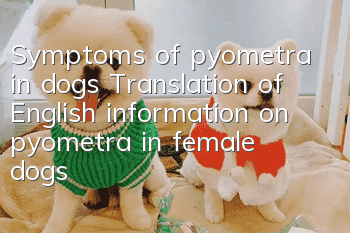Symptoms of pyometra in dogs Translation of English information on pyometra in female dogs

Pyometra English Wiki
Pyometra is an infection of the uterus. Although this is a disease widely thought of as affecting unneutered female dogs, it is also a disease of concern in humans and in cows, mares, ewes, sows, female cats, female rabbits, female hamsters, female ferrets, It is found in female animals such as female house mice and female guinea pigs. Pyometra is one of the main diseases that need to be paid attention to by dog owners, because this disease has sudden characteristics and can have fatal consequences if not treated in time. This disease has been compared to acute appendicitis in humans because both diseases are essentially pyometra in the abdominal organs.
Symptoms:
The most obvious symptom of open pyometra is the constant discharge of pus from the vulva of a female dog that has just ended estrus.
The symptoms of closed pyometra are not obvious.
Common features of both types of pyometra include nausea and vomiting, loss of appetite, lack of energy, increased water consumption, and increased urination. Closed pyometra is more serious than open pyometra, not only because there is no outlet for the (intrauterine) infection, but also because (the symptoms) are insidious and can easily be missed or misdiagnosed. Blood tests may show dehydration and/or an increased number of white blood cells. X-rays will show that the uterus is enlarged. An ultrasound shows the presence of fluid in the uterus.
Cause:
Different dog breeds have different risks of developing pyometra. Pyometra is the result of hormonal changes in the body and the lining of the uterus. Pyometra can occur in bitches of any age, whether they have given birth or not, and whether they are in their first or tenth heat, although pyometra becomes more common with age.
The most dangerous period for pyometra is within 8 weeks after the bitch’s ovulation period (estrus cycle) ends. The cervix that opens during estrus usually closes after ovulation, and the endometrium begins to return to normal. However, in response to changes in progesterone levels, a phenomenon called cystic endometrium (CEH), or cystic hyperplasia of the endometrium, may occur in some females during this period.
Under the above conditions, some bacteria (especially Escherichia coli) that enter the uterus from the vagina will grow in a suitable uterine environment. Progesterone causes the production of viscous secretions, which are used to close the cervix, reduce uterine contractions, and prevent uterine drainage. Pyometra may occur.
The state of the cervix is the main factor that determines the severity of pyometra:
If the cervix is open and infections can pass out of the body, this condition is called open pyometra and treatment is relatively Convenient and relatively safe at the same time. If the cervix is completely closed and there is no discharge from the vulva, just like appendicitis, the uterus may rupture and pus may enter the abdominal cavity, causing peritonitis, and rapid death may occur. The latter condition is called closed pyometra.
Hormonal Effects and Drug Injections:
Female animals that receive drug injections of estradiol during interestrus (medical abortion) are at high risk for pyometra because estrogen increases progesterone in the endometrium. number of receptors. Approximately 25% of females treated with estradiol develop pyometra during estrus. Pyometra is relatively rare in female cats because her ovaries only secrete progesterone after mating. In addition, the occurrence of pyometra in female cats is also related to breed.
Treatment:
The most important aspect of treating pyometra is providing prompt supportive care. Female dogs often go into septic shock and should be given intravenous fluids and antibiotics immediately. Once the female dog's condition is stable, neutering can be considered. In the treatment of a small number of livestock, placental medication can be selected, and antibiotics are recommended for supportive treatment. Severe cases require surgery.
Surgical therapy:
Sterilization surgery (ovariohysterectomy) can completely remove the infection, prevent uterine rupture and peritonitis, and of course prevent recurrence in most cases. Although a small number of sterilized animals still develop residual uterine pyometra, ovariohysterectomy is currently considered by the veterinary community to be the most effective and safe treatment.
- Is it better for Dogo dogs to have their ears erect or cropped? A case of Dogo dog’s ear erection surgery will tell you
- What do dogs eat to protect their stomach? It is important to protect their stomach and treat gastrointestinal diseases in dogs.
- How to tell if your dog is fat? Is your dog overweight?
- How to train Tibetan Mastiff Four aspects teach you how to train Tibetan Mastiff
- Will your dog catch a cold if you blow the air conditioner? What should you do if your dog catches a cold if you blow the air conditioner?
- What should you pay attention to when your dog drinks water? Don’t be careless when it comes to your dog’s drinking water.
- The dog's mouth bites and shakes. Why does the dog's mouth occasionally shake and bite?
- How to cut a dog's hair? Do you know how to cut a dog's hair correctly?
- Can dogs eat raw eggs? Why can’t dogs eat egg whites?
- Common Dog Problems in Summer How to Deal with Different Dog Problems



